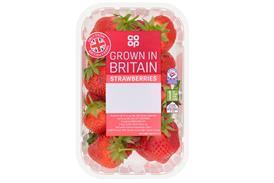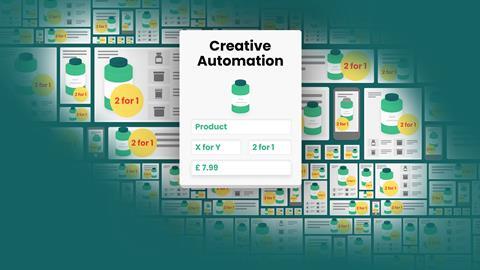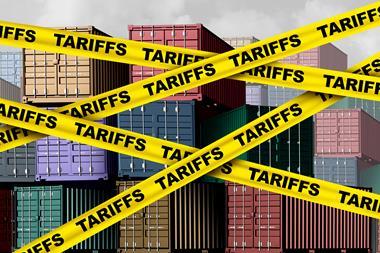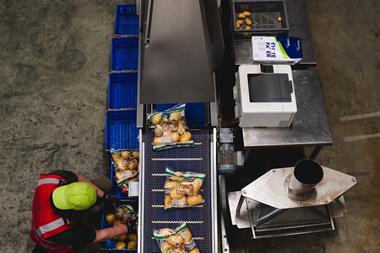For retail marketing teams, the pressure is on to create content that resonates across multiple channels – and the task is huge. Discover how creative automation can transform and streamline the process, optimising content creation and performance.
Retail marketing has become more complex over the years due to factors such as evolving ad formats, an increased number of marketing channels, stricter online and offline ad regulations, and the need for more localised or personalised content.
As a result, marketing teams are under pressure to produce an ever-growing number of diverse content assets. For retailers to mitigate this, one trend is to hire more creative staff in-house or increase production budgets for external agencies. But even for the biggest retailers, there is both a physical and financial limit.
Creative automation offers several ways to help retailers solve these complexities, enabling them to cut down on repetitive tasks, scale up content output and increase the production speed (time-to-market).
What is creative automation?
When a great product promotion comes in from category management, the first thing most retail marketers do is to put it in a promotions circular or sales leaflet. Then they ask creative production to extract this and create a social banner, in-store materials and maybe a price listing page image.
But that isn’t enough anymore. Now, there is a need for multiple variants for different social platforms, several segmented variants for CRM and, on top of that, maybe some more specific localised print materials for point of sale in different regions. And this is all for just one promotion. Imagine how the creative team feels about having to produce all of this content for hundreds of promotions, each week.
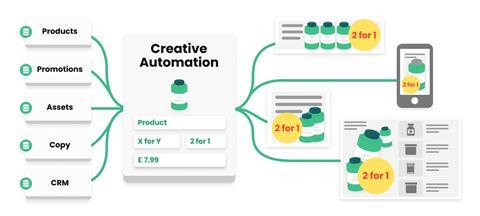
Creative automation can offer respite from this by starting at the source: category management data. By interpreting promotional + product data in a structured way, retail marketers can process it through business logic. For instance, how should certain promotional mechanisms look in different channels? Or how should the style for various CRM segments be defined? Creating a specific set of rules and design-system logic, even if it is just in writing, is the base for automating creative work.
Once that is documented and set up in the right tooling, such as Relayter, it is then possible to create smart automation templates that handle this logic input and create all the variants and localised versions of your promotions for any given channel. And this is all based on the same promotional input that would otherwise just be (manually) used to create one or a few specific content items.
So, what are the key benefits for retail?
● Go to market faster: With a strong automated promotional workflow – from category management and trade to creative production – retailers can save 50% or more on production times, getting content ready for print and digital distribution a lot faster.
● Win back creative time: Automated workflows handle repetitive tasks, freeing up time for marketing teams to focus on strategy, creativity and innovation.
● Scale up creative production: With creative automation, retailers can scale their marketing content output 10x or more without increasing their workforce.
● Optimise content performance: Automation gives the ability to create content at scale and try, test and optimise in a much more cost-efficient way.
● Personalise & localise: Automating data-to-creative-content processes gives the advantage to easily create segmented CRM-based online and offline content in any region or channel.
● Streamline campaign management: Creative automation streamlines the process of campaign creation, execution and optimisation. Retailers can use this automation to schedule and deploy marketing campaigns across multiple channels simultaneously, ensuring consistency in messaging and branding.
“We’ve been able to significantly improve cost effectiveness and time-to-market of all sales promotion leaflets, circulars, online banners and in-store materials through creative automation with Relayter. This is quite an achievement given the diversity and volume of promotions each week.”
– Wienke Truijen, AS Watson Benelux
Things to consider when starting with creative automation
Build a project team
The very first thing to do, is to align the three main stakeholders: category management, marketing and IT. Everybody needs to understand that this is a process to get a retail organisation future-proof and ready for the next big wave in marketing execution. It will take time, guts and a lot of good conversation to standardise promotional data, set up business rules, get the right software tooling and align the process for everybody involved.
Standardisation
When you have the team, one of the first challenges is to work on standardisation together. Try to reduce the many creative and well-meant custom promotion ideas down to a few good structured sets of mechanisms. Also, try to figure a way to structure design and brand elements for all your possible marketing channels, so that the brand consistency is high but flexible enough for different scenarios. Do not be afraid of complexity, but make it clear and reusable. This becomes the base for scalable content output.
Document your promotional, marketing and creative logic
We all have them… the few people that ‘know’ how things should look or how it ‘should’ be done, such as the Excel-specialist or the King-of-InDesign. But that gets you nowhere in terms of scale or automation. To get the right output with creative automation, you need well-documented business and design logic. This means writing down how various promotional types and mechanisms should look in different marketing channels – preferably with visual examples – as well as how brand guidelines should be interpreted in various outcomes. This will go much further than a brand book or style guide. Document how (promotional) data will transform into each creative outcome and this will become the creative automation bible for everyone, and the main reference guide to all content production.
To find out more about creative automation or view cases from AS Watson, Spar and Ahold Delhaize, click here

As an enterprise class cloud platform, Relayter fully integrates with all major PIM, DAM, ERP, Promo, CRM or ETL solutions. We provide large volume content automations based on flexible smart templates (digital and print), driven by product and promotional data input. With our flexible no-code engine and API-first connectivity we provide a true SaaS content automation solution for retail.
With Relayter you can create marketing content at scale.
www.relayter.com | https://www.linkedin.com/company/relayter/View full Profile



